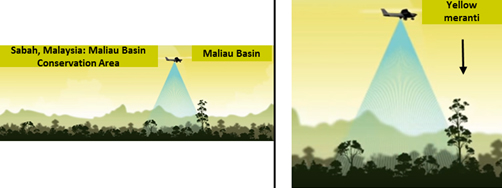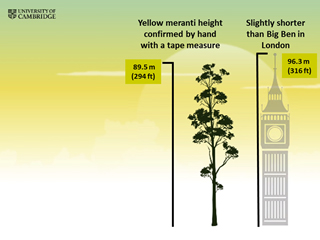 Purdue University - Extension - Forestry and Natural Resources
Purdue University - Extension - Forestry and Natural Resources
Got Nature? Blog
Check out the new publication entitled Benefits of Connecting with Nature now available in The Education Store!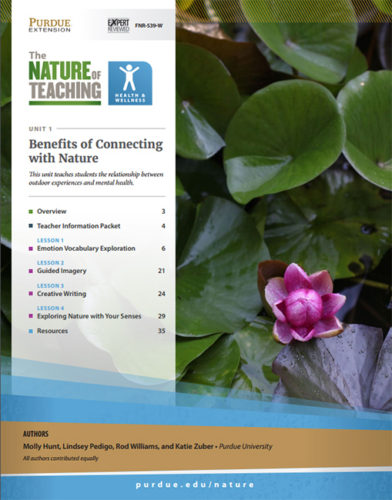
Times are constantly changing with the growth and integration of technology within society. As we become more and more reliant on technology for information and entertainment, we seem to be detached from many vital aspects of our world. People, especially children, are losing their touch with the outdoors. Recent reports show that children ages 6–11 spend an average of 28 hours per week watching television. The average amount of time children spent using mobile devices tripled between 2011–2013.
Natural environments have positive impacts on people’s mental health and well-being. Studies consistently show that natural settings link to much stronger developmental benefits for children.
This unit will help teachers explore student’s relationship between nature and mental health. It contains four 30-40 minutes activities: Emotion Vocabulary Exploration, Guided Imagery, Creative Writing and Exploring Nature with your Senses.
Resources:
The Nature of Teaching – Purdue Extension
Got Nature – Podcast, The Education Store
Appreciating Reptiles and Amphibians in Nature –The Education Store
Frogs and Toads of Indiana – The Education Store
Molly Hunt, Extension Educator, Delaware County
Purdue University Extension Health and Human Sciences
Katie Zuber, Extension Educator, Lawrence, Jackson, Monroe and Brown County
Purdue University Extension Health and Human Sciences
Lindsey Pedigo, Extension Educator, Howard County
Purdue University Extension Health and Human Sciences
Rod N Williams, Associate Head of Extension & Associate Professor of Wildlife Science
Purdue University Department of Forestry and Natural Resources
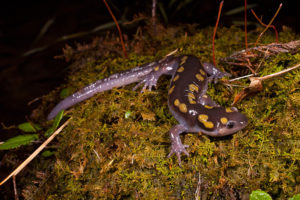
The Spotted Salamander (Ambystoma maculatum) is a common species of mole salamander. Photo credit: T. Travis Brown.
I have been asked some variation of this question multiple times over the past several years. Sometimes the “hellbender” is found in a barn, on a basement floor, crawling across a driveway, or occasionally in a pond. The common denominator is always that someone has found a salamander, and they are concerned it is an Eastern Hellbender that needs help.
I appreciate this concern. I am glad to see that people have become more aware of the existence of the Eastern Hellbender and that it is something worth helping. The Eastern Hellbender is an endangered species in Indiana, and we always welcome reports from concerned citizens. However, the Eastern Hellbender is a very rare species in Indiana and is uncommon throughout most of its range in the eastern United States. The species has been declining in Indiana over the past several decades and is now known only from the Blue River in Washington, Harrison, and Crawford Counties. For this reason alone, it is unlikely that anyone would find a Hellbender on their property.
However, another equally important reason that it is unlikely a Hellbender involves the species biology. The Eastern Hellbender is fully aquatic and lives exclusively in rivers and streams. Unlike most amphibians, its primary means of respiration is by absorbing oxygen directly from the water through its skin. One adaptation Hellbenders have evolved to help with oxygen absorption is the development of wavy skin-folds along the sides of their bodies. These skin-folds provide greater surface area for oxygen absorption. Hellbenders have lungs, but they do not function well enough to allow them to survive extended periods of time on land. Hellbenders have been found on land immediately next to rivers and streams, but this is rare and is generally considered an anomaly.
While this rules out finding them on land away from rivers and streams, what about ponds and lakes? Hellbenders typically prefer clean, cool, swift flowing rivers and streams with a high oxygen content. These conditions are not typically found in ponds and lakes, and would make it unlikely that hellbenders would willingly reside in them. Moreover, these water bodies are usually landlocked with no close access from rivers and streams, and since hellbenders do not like to travel overland, they will likely never encounter a pond or lake.
There are two unlikely possibilities that might result in a Hellbender being found in a pond or lake. The first would be if someone captured a hellbender and moved it there. The second would be a pond or lake owner that lives in the floodplain of a river containing Hellbenders. Hellbenders do occasionally get dislodged by flooding and washed downstream. A large flood has the potential, however unlikely, to wash a Hellbender into a nearby pond. I am unaware of this ever happening, but it is a possibility.
So if you haven’t found a Hellbender, what have you found? If you found your salamander on land, it is very likely one of a group of salamanders known as mole salamanders. Mole salamanders are common throughout most of Indiana. They typically breed in ponds in the spring and then hide under logs or bury themselves underground. They are commonly found during spring breeding migrations and are frequently seen in large numbers. They often times find themselves wandering onto our properties and getting stuck in window wells or hiding themselves under rocks, firewood, or in our barns.
If you found your salamander in the water then it could be either the aforementioned mole salamander or a Common Mudpuppy. Mudpuppies are commonly confused with hellbenders and do live in ponds, wetlands, and creeks. Like the Hellbender, they are fully aquatic and don’t go on land except in very rare circumstances. Mudpuppies have large, fluffy gills behind their heads, which Hellbenders do not have. Mudpuppies also lack the skins folds along the sides of their bodies.
While most people will go their entire lives without ever seeing a Hellbender, if you live in the right areas it is a possibility. If you think you have seen a Hellbender, then please take a photo and let us know by visiting our Hellbender Reporting Webpage below. We are always happy to help.
Resources:
Hellbender ID – video, The Education Store, Purdue Extension resource center
HelptheHellbender.org, Purdue Extension
Help the Hellbender: North America’s Giant Salamander, The Education Store
Salamanders of Indiana, The Education Store
Appreciating Reptiles and Amphibians, The Education Store
Nick Burgmeier, Research Biologist and Extension Wildlife Specialist
Purdue Department of Forestry and Natural Resources
 If you or someone you know loves to learn about wildlife, especially reptiles and amphibians, then you will be interested in our new special offer package. We are offering our complete collection of reptile and amphibian field guides (4 softcover books) for 10% of the price of each individual book. These books cover all of the reptiles and amphibians that are found in the state of Indiana. They include detailed physical descriptions, distribution maps, and interesting information about the ecology of each species. All of the included books have been peer-reviewed by experts in the field of herpetology.
If you or someone you know loves to learn about wildlife, especially reptiles and amphibians, then you will be interested in our new special offer package. We are offering our complete collection of reptile and amphibian field guides (4 softcover books) for 10% of the price of each individual book. These books cover all of the reptiles and amphibians that are found in the state of Indiana. They include detailed physical descriptions, distribution maps, and interesting information about the ecology of each species. All of the included books have been peer-reviewed by experts in the field of herpetology.
The Indiana Amphibian and Reptile ID Package can be purchased from the Purdue Education Store for $36.00.
Additional Resources, The Education Store, Purdue Extension:
Frogs and Toads of Indiana
Salamanders of Indiana
Snakes and Lizards of Indiana
Turtles of Indiana
More Resources Available:
Help the Hellbender, Purdue Extension
The Nature of Teaching, Lesson Plans K-12, Purdue Extension
Nick Burgmeier, Research Biologist and Extension Wildlife Specialist
Purdue Department of Forestry and Natural Resources
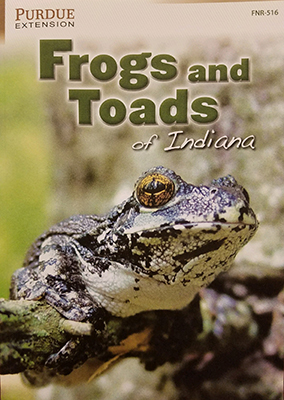 Frogs and Toads of Indiana is the latest and final addition to Purdue Extension’s line of field guides focused on the reptiles and amphibians of Indiana. Readers of this guide will not only learn how to ID the Anuran species of Indiana but will also learn about their distribution throughout the state along with their habits and behaviors. The guide is richly illustrated, filled with interesting facts, and has been peer-reviewed by expert herpetologists.
Frogs and Toads of Indiana is the latest and final addition to Purdue Extension’s line of field guides focused on the reptiles and amphibians of Indiana. Readers of this guide will not only learn how to ID the Anuran species of Indiana but will also learn about their distribution throughout the state along with their habits and behaviors. The guide is richly illustrated, filled with interesting facts, and has been peer-reviewed by expert herpetologists.
As many herpetologists and recreational herpers can attest, seeing what you are hearing is not always possible. With this in mind, we developed a website The Frogs and Toads of Indiana for users that wish to learn the calls of Indiana Anuran species.
The Frogs and Toads of Indiana, FNR-516, can be purchased from the The Education Store for $10.00.
Resources, The Education Store-Purdue Extension resource center:
Salamanders of Indiana
Snakes and Lizards of Indiana
Snakes of the Central and Northeastern United States
Turtles of Indiana
Additional resources:
The Nature of Teaching, Lesson Plans K-12, Purdue Extension
Nick Burgmeier, Research Biologist and Extension Wildlife Specialist
Purdue Department of Forestry and Natural Resources
In August of 2016, we posted an article about how the online game Minecraft teaches forest regeneration and helps users understand the pros and cons of various tree species. This year, we bring you information about Pokémon GO a game designed for your smartphone. While the premise of the game is to find cute creatures to befriend and train for battle, this game ultimately teaches additional lessons about nature and conservation.
After being released July 6, 2016, popularity for Pokémon GO exploded around the globe. With more than 500 million downloads in the first two months, this mobile phone game has brought cartoon Pokémon from television to more children and adults than ever before. Virtual Pokémon on your mobile screen appear to be a part of your real-world environment. As you catch, train, and battle your Pokémon, lessons about natural history and conservation are being taught and absorbed without you being aware of it.
Playing Pokémon GO is akin to bird watching as these creatures exist as “real” animals found outdoors that can be caught and collected. In their efforts to catch rare species, more people are venturing outdoors and visiting parks and conservation areas. With the new interest in visiting the outdoors, interactions with ‘real’ animals in nature have also increased. The Twitter hashtag #Pokeblitz is a repository for photos of wildlife species observed during play.
Players learn basic concepts such as habitat preferences. For example, ‘Grass Pokémon’ are most often found in parks, forests, or conservation areas while water-types can be found nearest to water sources. In addition, lessons regarding native regions are also taught as some species can only be found in certain continental regions. The Pokémon ‘Tauros’, a bull with multiple tails, is native to the Americas, ‘Mr Mime’, humanoid fairy, to Western Europe, ‘Farfetch’d’, an aggressive duck-like creature, to Asia, and the marsupial-like ‘Kangaskhan’ to Australasia. The take-away lesson most players learn is that exploration of new areas and continents will yield new species.
Newly published research from scientists at Oxford, Cambridge, UNEP World Conservation Monitoring Centre, and the University College London (UCL) explored whether the game posed more problems for conservation efforts as gamers focused more on the virtual
than real animals or solutions to getting more people to explore the outdoors. They list pros and cons and their suggestions below:
The pros:
- More people are venturing outside and learning about nature
- There is a renewed interest in habitat conservation
- All you need is a smartphone
The cons:
- The brightly-colored and engaging Pokémon are not a true representation of actual wildlife
- Battling Pokémon in the game could encourage exploitation of ‘real’ animals.
Suggestions:
- Make the Pokémon more realistic (biology and ecology)
- Add real species to the Pokémon GO universe to raise awareness of these species
- Place Pokémon in more remote areas to draw people out of the cities
- Add a mechanism to catalogue real species to build upon #Pokeblitz
- Use Pokémon GO lessons to develop augmented reality (AR) games about real species and conservation efforts where users look for and catalog species for educational purposes.
If there were any doubts about the game’s popularity, hundreds upon hundreds of people converged in Central Park one night last summer in a contest to find the rare Pokémon ˈVaporeonˈ said to be inhabiting the park. A last thought from scientists was that true conservation efforts could wane as finding virtual species outweighs protecting endangered ˈrealˈ species. However, engagement efforts with the public regarding conservation can take notes from the responsive Pokémon as many current efforts are full of scientific terms and tend to be off-putting to a general audience. The popularity of Pokémon GO has implied that the public can be reached but we need other ways of relaying information that encourage additional learning.
Literature Cited:
Dorward LJ, Mittermeier JC, Sandbrook C, Spooner F. 2016. Pokémon Go: Benefits, Costs, and Lessons for the Conservation Movement. Conservation Letters doi: 10.1111/conl.12326.
Resources:
Can online gamin help improve your knowledge of forest trees?, Purdue Extension-FNR Got Nature?
Shaneka Lawson, USDA Forest Service/HTIRC Research Plant Physiologist/Adjunct Assistant Professor
Purdue University Department of Forestry and Natural Resources
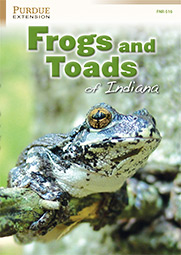
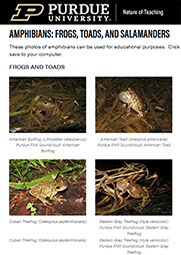
Videos:
Ask an Expert: Anurans (Frogs and Toads)
Ask an Expert: Salamanders
A Moment in the Wild: Wood Frogs
A Moment in the Wild: American Toad
A Moment in the Wild YouTube Playlist-Subscribe
Reptiles, Amphibians & the Scientific Method
Learn All About Hellbenders and Take a Tour
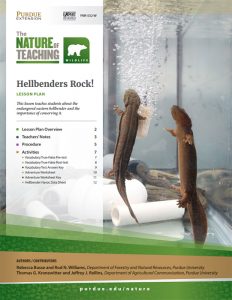 This new lesson plan from The Nature of Teaching titled Hellbenders Rock! is full of engaging activities to teach K-5 students about the endangered eastern hellbender, while meeting Indiana academic standards. Hellbenders Rock is available as a free download in The Education Store, complete with instructional PowerPoint, videos, vocabulary worksheets, along with instructions on how to download the free Hellbender Havoc app.
This new lesson plan from The Nature of Teaching titled Hellbenders Rock! is full of engaging activities to teach K-5 students about the endangered eastern hellbender, while meeting Indiana academic standards. Hellbenders Rock is available as a free download in The Education Store, complete with instructional PowerPoint, videos, vocabulary worksheets, along with instructions on how to download the free Hellbender Havoc app.
This lesson is unique in the way that it requires teachers to download the free Hellbender Havoc app from the Google Play Store or Apple App Store to help students apply the educational content learned throughout the lesson. The lesson requires 60 minutes of class time to complete, including time for the students to play the app and complete the worksheets that accompany it. Throughout the lesson, students learn how to identify the eastern hellbender, how to describe the hellbender’s lifecycle, how the hellbender relates to healthy water quality, and how we can help the hellbender.
To find more nature-themed lesson plans that incorporate academic standards and teach material in hands-on and engaging ways, visit The Nature of Teaching website. All lesson plans are free to download. To learn more about the eastern hellbender and how we can help, visit helpthehellbender .org.
Resources:
Hellbenders Rock! Lesson Plan, The Education Store, Purdue Extension Resource Center
The Nature of Teaching, Purdue Extension
Help the Hellbender, Purdue Extension
Hellbender Havoc App-Google Play Store or Hellbender Havoc-Apple App Store
Rebecca Busse, Graduate Student
Purdue Department of Forestry and Natural Resources
Rod Williams, Associate Professor of Wildlife Science
Purdue Department of Forestry and Natural Resources
 People can be taken aback by the sight of squirrels missing hair. Sightings of partially furred squirrels is not unusual with warmer temperatures experienced through the winter. Like many wildlife issues, the cause of hair loss in squirrels is not easy to answer and often results in more questions than answers. In most situations, hair loss does not impact populations of squirrels. However, individuals may be impacted during winter.
People can be taken aback by the sight of squirrels missing hair. Sightings of partially furred squirrels is not unusual with warmer temperatures experienced through the winter. Like many wildlife issues, the cause of hair loss in squirrels is not easy to answer and often results in more questions than answers. In most situations, hair loss does not impact populations of squirrels. However, individuals may be impacted during winter.
Most people assume, often incorrectly, that hair loss in squirrels is the result of mange, a disease caused by microscopic mites that burrow into the skin and are unseen by the naked eye. Hair loss attributed to the squirrel mange mite, Notoedres douglasi, has been reported in both fox and gray squirrels. Notoedric mange is different from sarcoptic mange. The latter, caused by the mite Sarcoptes scabiei, occurs primarily among red foxes and coyotes. Questions exist regarding the host specificity of mange mites. In light of new evidence, some pathologists now believe that sarcoptic mange mites are not as host-specific as previously thought. However, notoedric mange mites appear to be more host-specific, and don’t colonize non-hosts (like humans), although a few bites may occur. Transmission of notoedric mange to species other than squirrels has not been documented, including to canine and feline pets.
Symptoms of notoedric mange in squirrels includes loss of hair and dry, thickened and dark skin. Crust does not form on the skin in notoedric mange in squirrels like it does in sarcoptic mange in red fox. Mange is most commonly spread by direct animal to animal contact. Treatment of adult squirrels with mange is generally not recommended because reinfection from their nest is likely. An adult squirrel can survive mange if in otherwise good condition. While mange can be fatal to squirrels as a result of exposure during the winter, full recovery is often observed in squirrels.
While mange is commonly presumed to be the culprit, most hair loss in squirrels is caused by a variety of superficial fungal diseases generally termed dermatophytoses. Hair from squirrels infected with fungal agents is typically broken off at the skin, leaving a fine stubble of short hairs. Damp weather is thought to play a role in some fungal outbreaks. This past autumn was relatively wet for Indiana standards and may have contributed to the apparent observed increase of hair loss in squirrels this winter. Most animals will eventually gain an immune response and recover from the fungal infection without any apparent consequences.
Some hair loss in gray and flying squirrels is thought to be an inherited condition where the hair follicles are non-functional or absent, although studies confirming this have not been done. These squirrels have normal, but bare skin.
The next time you see a squirrel with hair loss, don’t become alarmed. In most cases, the hair will return with no apparent ill affects to the squirrel, other than perhaps some embarrassment and name calling among his squirrel friends.
Resources:
Indiana Animal Disease Diagnostic Laboratory
Indiana DNR Permitted Wildlife Rehabilitators, Indiana Department of Natural Resources (IN DNR)-Fish & Wildlife
Orphaned Wildlife, Got Nature? blog
Orphaned & Injured Animals, Indiana Department of Natural Resources (IDNR)
Brian MacGowan, Wildlife Extension Specialist
Purdue University, Department of Forestry and Natural Resources
 The display of color we enjoy each fall is explained by understanding plant pigments, the physiology and anatomy of leaves, and the influence of climate and seasonal weather conditions. Fall weather conditions favoring formation of bright red autumn color are warm sunny days followed by cool but not freezing nights.
The display of color we enjoy each fall is explained by understanding plant pigments, the physiology and anatomy of leaves, and the influence of climate and seasonal weather conditions. Fall weather conditions favoring formation of bright red autumn color are warm sunny days followed by cool but not freezing nights.
Check out the Why Leaves Change Color publication for the answer along with other hardwood tree information.
Resources
Fifty Trees of the Midwest App for the iPhone, The Education Store
Native Trees of the Midwest, The Education Store
Shrubs of Indiana CD: Their Identification and Uses, The Education Store
Shrubs and Woody Vines of Indiana and the Midwest: Identification, Wildlife Values and Landscaping Use, The Education Store
Trees of Indiana CD, The Education Store
Lenny Farlee, Sustaining Hardwood Extension Specialist
Purdue Department of Forestry and Natural Resources

Photo from www.flickr.com
An article published on June 8th, 2016 by the University of Cambridge noted that a new record-holder for the tallest tree in the tropics is the same species as a tree used in the extremely popular game Minecraft. The trees in Minecraft proceed to follow standard growth patterns from saplings to mature trees. Care has been taken by game designers to adjust leaf color and the colors of the surrounding foliage to depict a certain setting. There are even provisions for dying or fallen trees which in the game are often covered in mushrooms and vines. Some of these decomposing trees will actually resprout and begin growth again as saplings. Trees available for planting are grouped into Acacia (Acacia spp.), Birch (Betula spp.), Oak (Quercus spp.) and Dark Oak (Q. spp), Jungle (no specific species), and Spruce (Picea spp.) species and can each be found and grown in a unique biome environment. Several of these tree species (i.e. Acacia, Oak) are also researched here at Purdue.

Photo from www.flickr.com
In the game, a Yellow meranti (Shorea faguetiana or Shorea acuminatissima); also known as the Philippine mahogany, is one of the selections available for use. This species is native to Indonesia, Malaysia, the Philippines, and Thailand but is severely threatened by habitat loss and destruction. Yellow meranti can grow upwards of 200 ft tall and greater than 6 ft in diameter. The wood from the tree is lightweight, durable, and has been used for everything from light furniture to crates. The wood more often than not also contains figure which makes it a valuable commodity in the veneer industry as well.
The spotlight has been put on Minecraft after the recent discovery of a 294 ft tall Yellow meranti tree growing in the Maliau Basin Conservation Area in Malaysia. This area is one of the few regions on earth where pristine rainforest ecosystems are being actively monitored and protected. This tree is actually growing on a downhill slope thus its actual height has been recorded as 299 ft. This tree is slightly taller than the previous record and makes it the “unofficial” tallest tree in the Tropics.
The use of actual tree species that require maintenance in a game that has player numbers in the millions to help inform the young and old alike about the value of trees and some of the different species is genius.
More than 12 million people play Minecraft on the PC, 9 million people play on Xbox, and 6 million people play it on the iPad, iPod, or Android. More than 20,000 people buy the game daily, 3.2 million people log on and play it each day (on all of the versions), and 5 people per second buy the game. Thus, nearly 28 million people own the game and more than 1 million are logged in at any given time day or night. All of these individuals are being taught about trees and how to maintain them without even realizing how much they have learned. With news of a movie version of Minecraft being scripted, untold numbers of movie goers will likely buy the game beforehand and learn even more about trees.
The Malaysian government is extremely proud of the potential world record discovery within their forests and seek to highlight the importance of maintaining the biodiversity within the country. Their collaboration with the Natural Environment Research Council (NERC), Cambridge University, the Sabah Forestry Department, the South-East Asia Rainforest Research Partnership and the NERC Airborne Remote Sensing Facility has been extremely fortuitous. Future plans are to protect and restore a huge tract of heavily logged forest east of where this Yellow meranti tree was found.
For more information on Malaysia’s potentially record-breaking tree, check out Cambridge University’s article Minecraft tree “probably” the tallest tree in the Tropics.
Resources:
Minecraft tree “probably” the tallest tree in the Tropics Research Article- Cambridge University
Tree – Foliage colors – Minecraft Wiki
Sale Stats – Minecraft
Getting Started With Minecraft – Minecraft101
Yellow Meranti – The Wood Database
Dr. Shaneka Lawson, USDA Forest Service/HTIRC Research Plant Physiologist/Adjunct Assistant Professor
Purdue University Department of Forestry and Natural Resources
Recent Posts
- Magnificent Trees of Indiana Webinar
Posted: May 12, 2023 in Forestry, Forests and Street Trees, Gardening, Got Nature for Kids, Urban Forestry, Webinar, Woodlands - “Fifty Trees of Indiana” Now Has New Name and New Additional Trees
Posted: January 13, 2022 in Forestry, Forests and Street Trees, Got Nature for Kids, How To, Urban Forestry, Woodlands - Multidisciplinary Cicada Outreach Team Honored by PUCESA
Posted: January 7, 2022 in Ask the Expert, Forests and Street Trees, Got Nature for Kids, Urban Forestry, Wildlife - Introduction to Nature of Teaching Sneak Peek Videos
Posted: November 2, 2020 in Aquaculture/Fish, Aquatic/Aquaculture Resources, Gardening, Got Nature for Kids, How To, Land Use, Nature of Teaching, Plants, Ponds, Urban Forestry, Wildlife, Woodlands - Nature of Teaching Program Receives Environmental Education Award
Posted: October 30, 2020 in Aquaculture/Fish, Aquatic/Aquaculture Resources, Disease, Drought, Forestry, Forests and Street Trees, Gardening, Got Nature for Kids, How To, Invasive Animal Species, Invasive Insects, Land Use, Natural Resource Planning, Nature of Teaching, Plants, Ponds, Safety, Wildlife - New Publication – The Nature of Teaching: Disease Ecology
Posted: May 20, 2020 in Disease, Forestry, Got Nature for Kids, How To, Nature of Teaching, Plants, Ponds, Publication, Wildlife - Join us on Facebook LIVE – Hellbender Virtual Tour
Posted: April 20, 2020 in Forestry, Got Nature for Kids, Wildlife, Woodlands - The Nature of Teaching: Adaptations for Aquatic Amphibians
Posted: May 14, 2019 in Alert, Aquaculture/Fish, Aquatic/Aquaculture Resources, Got Nature for Kids, How To, Nature of Teaching, Ponds, Publication, Safety, Wildlife - Can Groundhogs Predict the Weather?
Posted: January 31, 2019 in Forestry, Forests and Street Trees, Got Nature for Kids, Urban Forestry, Wildlife, Woodlands - Publication and Lesson Plans for Food Waste and Natural Resources
Posted: December 12, 2018 in Got Nature for Kids, Natural Resource Planning, Nature of Teaching, Publication
Archives
Categories
- Alert
- Aquaculture/Fish
- Aquatic/Aquaculture Resources
- Ask the Expert
- Christmas Trees
- Community Development
- Disease
- Drought
- Forestry
- Forests and Street Trees
- Gardening
- Got Nature for Kids
- Great Lakes
- How To
- Invasive Animal Species
- Invasive Insects
- Invasive Plant Species
- Land Use
- Natural Resource Planning
- Nature of Teaching
- Plants
- Podcasts
- Ponds
- Publication
- Safety
- Timber Marketing
- Uncategorized
- Urban Forestry
- Webinar
- Wildlife
- Wood Products/Manufacturing
- Woodland Management Moment
- Woodlands




